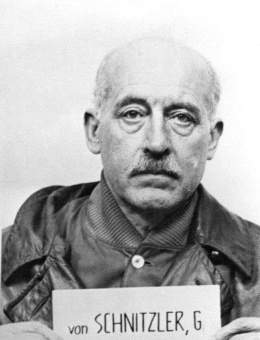Georg von Schnitzler (1884–1962)

© National Archives, Washington, DC
“Q[uestion]: What did you do when you heard that I.G. chemicals were used to kill, to murder people held in concentration camps?
A[nswer]: I was horrified […] I kept it for me because it was too terrible. I was always under the impression that these gases were not manufactured by us.”[1]
Georg von Schnitzler was born in Cologne on October 29, 1884. He studied law in Bonn, Leipzig, and Berlin, and received his doctorate at the University of Leipzig in 1907, writing a dissertation on “No-Fault Liability for Damages.” Previously he had served as a one-year volunteer in a hussar regiment of the German Army. After a year-long world trip, he worked for a bank in Cologne, Bankhaus J. H. Stein. In 1910, he married Lily von Mallinckrodt.
In 1912, he joined Farbwerke Hoechst (vorm. Meister Lucius & Bruening), where his father was a member of the supervisory board. He worked in dye sales there, in a Munich branch office. In 1919, he was made an authorized signatory at Hoechst and, one year later, an alternate member of the managing board, with full membership granted in 1924. In 1925, he was one of the lawyers working on the merger agreements for I.G. Farben, and the next year he became an alternate member of the new conglomerate’s managing board. In 1930, Georg von Schnitzler took over the management of the sales departments of I.G. Farben. In addition, he conducted the negotiations with French chemical manufacturers that resulted in 1927 in the creation of the German-French dye cartel, which by 1932 was expanded to include Swiss and British chemical firms. In February 1933, von Schnitzler supported the financing of the NSDAP’s campaign, and in 1934 he joined the SA, where he attained the rank of Hauptsturmführer. In 1937, Georg von Schnitzler became chairman of the Commercial Committee of the I.G. and joined the NSDAP.
In 1942, he was named a “military economy leader” (Wehrwirtschaftsführer), and in 1943 von Schnitzler became chairman of the Chemical Committee and as such, a participant in the takeover of French and Polish chemical firms.
After the war ended, he was arrested by the U.S. Army and charged with “plunder and spoliation” in the I.G. Farben Trial at Nuremberg. On July 30, 1948, he was sentenced to a prison term of five years
(SP; transl. KL)
















